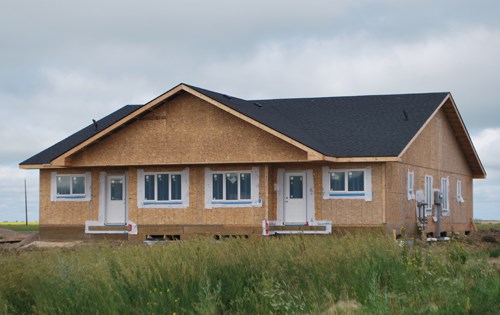If you were new to Carlyle, where would you live? Unfortunately, that very question is faced by the majority of individuals that move to Carlyle.
Canadian Home Builders' Association stated in a June press release that housing development in Saskatchewan is strong and steady. "Saskatchewan's housing market and economy are an anomaly in Canada, which is bracing for another potential economic and housing slowdown. Despite weaker predictions for other provinces, based on the strength of our resource based industries, the productivity of our workers and the optimistic outlook of investors for our continued growth, Saskatchewan is expected to experience strong growth for 2011 and beyond. Investment in housing and residential development will need to keep pace with forecasts for growth in order to provide everyone in the provinces have access to safe, high quality and appropriated homes."
Despite this increase in housing developments throughout Saskatchewan, access to housing in Carlyle is a characteristic that still needs addressed. Moving to Carlyle often means building a home or paying inflated housing prices. The option to rent is minimal to non-existent. For those middle-class families, the local housing market does not ensure available housing. The influx of workers in the oil and gas industry in addition to a growing economy and an increase in housing costs due to limited availability, has created a situation where moving to the area is a challenge in itself.
Marilyn Carter of the Carlyle Housing Authority stated there "has always been a need for more rental property. With the lakes and the oil fields and all these other companies, there is a need for housing. While lots of jobs exist in the area, there is no place for people to move to."
On average during the months of May and June, the housing authority received more than five phone calls a week regarding available rental units. "A lot [of the calls] are based on a husband working here, who is trying to get his family here. The waiting list is the same it has always has been which is really sad because you can't even give anyone the hope that within two or three months, we can help them. People have the opportunity to live here [job-wise], they just don't have anywhere to live."
The housing authority is currently in charge of two apartment buildings with 24 units that exist for middle income individuals, as well as nine houses designated towards low income families. An additional 40 senior citizens are provided with housing by the authority. For these units and housing categories, the housing authority has a waiting list of more than 45 applications.
So what is being done to address the challenge of housing in the area?
In July of 2008, the town of Carlyle faced the fact that there were no residential lots left in the town. Looking at the zoning bylaw from 1978, the council decided that a community plan was required in order to create a long-term vision for the community. Phases one through three of the development plan would include the development of 77 lots over the years to follow. Initial plans to create the lots phase-by-phase was challenged by the demand. The result was the decision to go ahead with phase one and two, creating 42 residential lots for the town. Phase three is yet to occur and will result in 35 additional lots.
At this point in time, only 29 residential lots remain available in the community of Carlyle. After these lots have been purchased, the town of Carlyle will have to look into other options such as the purchase of land from the RM. Since January of this year, six houses have been built with two or three more applications expected to come in shortly.
Additionally, Carlyle is experiencing an increase in the number of external developers that are bringing housing units into Carlyle. These units range from condos to townhouses to four-plexes, all in an attempt to sell quickly to a public that requires housing immediately.
The housing challenge is not Carlyle specific. The challenge is faced by those throughout the region and as a result, the SSEER (Saskatchewan South East Enterprise Region) was established to provide a working group on housing. The group includes eleven municipalities including the cities of Estevan and Weyburn, along with the towns of Alameda, Bienfait, Carlyle, Carnduff, Kipling, Lampman, Oxbow and Redvers, and the RM of Browning.
At this point, SSEER is near completion of phase one of the regional housing initiative. This has included the hosting of two stakeholder meetings and a regional assessment of how the lack of affordable housing has impacted economic development, a study performed by an external consultant.
The SSEER is also following a community planning process as outlined by the CMHC Guide for Canadian Municipalities for the Development of a Housing Action Plan. The organization's CEO, Edie Spagrud, is meeting with each municipal council to provide them with information on the assessment and planning process. At this time, the CEO has met with town of Carlyle to discuss the development of a housing action committee.
And the initiative continues to move forward. The organization has applied for funding which would allow for the hiring of a coordinator to continue working with communities to develop housing action plans and research and collect appropriate data. Carlyle will continue to take part in the initiative in hopes of creating an action plan that meets the needs of the community.
A recent newsletter from the SSEER stated that "the province announced that some funding assistance would be made available to communities for affordable housing development, pending assessment of information collected from recent public consultations throughout the province. [It is] expected [that] regional housing initiatives and communities that have completed their needs assessment and housing action plan will be well positioned to qualify for future government housing assistance programs."



